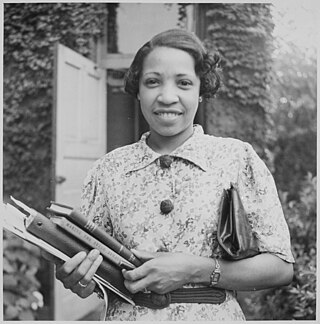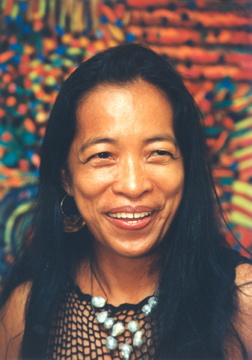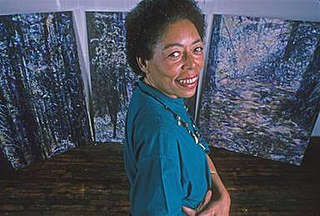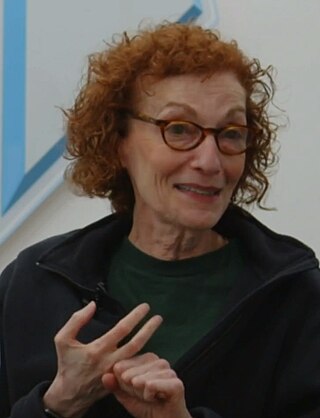
Lois Mailou Jones (1905–1998) was an artist and educator. Her work can be found in the collections of the Smithsonian American Art Museum, The Metropolitan Museum of Art, the National Museum of Women in the Arts, the Brooklyn Museum, the Museum of Fine Arts, Boston, Muscarelle Museum of Art, and The Phillips Collection. She is often associated with the Harlem Renaissance.

Faith Ringgold was an American painter, author, mixed media sculptor, performance artist, and intersectional activist, perhaps best known for her narrative quilts.
Wangechi Mutu is a Kenyan American visual artist, known primarily for her painting, sculpture, film, and performance work. Born in Kenya, Mutu now splits her time between her studio there in Nairobi and her studio in Brooklyn, New York, where she has lived and worked for over 20 years. Mutu's work has directed the female body as subject through collage painting, immersive installation, and live and video performance while exploring questions of self-image, gender constructs, cultural trauma, and environmental destruction and notions of beauty and power.
Kay WalkingStick is a Native American landscape artist and a member of the Cherokee Nation. Her later landscape paintings, executed in oil paint on wood panels often include patterns based on Southwest American Indian rugs, pottery, and other artworks.

Linda Vallejo is an American artist known for painting, sculpture and ceramics. Her work often addresses her Mexican-American ethnic identity within the context of American art and popular culture. The founder of the commercial art gallery Galería Las Américas, she is also an arts educator and has been involved intraditional Native American and Mexican rituals and ceremonies for many years.

Pacita Barsana Abad was an Ivatan and Filipino-American artist. Her more than 30-year painting career began when she traveled to the United States to undertake graduate studies in Spain. She exhibited her work in over 200 museums, galleries and other venues, including 75 solo shows, around the world. Abad's work is now in public, corporate and private art collections in over 70 countries.

The Dennos Museum Center is a fine art museum and cultural center located in Traverse City, Michigan on the campus of Northwestern Michigan College (NMC). Most notable for its permanent collection of Inuit art, the Dennos Museum opened in 1991 and features rotating exhibitions of Modern and Contemporary art.
Sonya Fe (1952) is a Chicana painter born and raised in Los Angeles.
Adriana Varejão is a Brazilian artist. She works in various disciplines including painting, drawing, sculpture, installation and photography. She was an artist-in-resident at the Isabella Stewart Gardner Museum in 2004. Varejão lives and works in Rio de Janeiro.

Sonya Clark is an American artist of Afro-Caribbean heritage. Clark is a fiber artist known for using a variety of materials including human hair and combs to address race, culture, class, and history. Her beaded headdress assemblages and braided wig series of the late 1990s, which received critical acclaim, evoked African traditions of personal adornment and moved these common forms into the realm of personal and political expression. Although African art and her Caribbean background are important influences, Clark also builds on practices of assemblage and accumulation used by artists such as Betye Saar and David Hammons.

Howardena Pindell is an American artist, curator, critic, and educator. She is known as a painter and mixed media artist who uses a wide variety of techniques and materials. She began her long arts career working with the New York Museum of Modern Art, while making work at night. She co-founded the A.I.R. gallery and worked with other groups to advocate for herself and other female artists, Black women in particular. Her work explores texture, color, structures, and the process of making art; it is often political, addressing the intersecting issues of racism, feminism, violence, slavery, and exploitation. She has created abstract paintings, collages, "video drawings," and "process art" and has exhibited around the world.

Teresa Margolles is a conceptual artist, photographer, videographer, and performance artist. As an artist she researches the social causes and consequences of death.
Mequitta Ahuja is a contemporary American feminist painter of African American and South Asian descent who lives in Baltimore, Maryland. Ahuja creates works of self-portraiture that combine themes of myth and legend with personal identity.
Rocio Caballero is a Mexican figurative painter, whose works often depict mythical worlds and are noted for her use of symbolism. Her work has been exhibited individually and collectively in Mexico, the United States, South America and Europe and can be found in collections such as that of the National Museum of Mexican Art. Her work has been recognized with membership in the Salón de la Plástica Mexicana.

María Eugenia Chellet is a Mexican artist who has evolved from photography to mixed media and currently focuses mostly on performance. Her work focuses on exploring female archetypes and other images relating to femininity, often using herself in roles such as female Biblical figures, those in classical artwork and those from commercial mass media of the 20th century to the present. Her work has been recognized with membership in the Salón de la Plástica Mexicana.

Vivian E. Browne was an American artist. Born in Laurel, Florida, Browne was mostly known for her painting series called Little Men and her Africa series. She is also known for linking abstraction to nature in her tree paintings and in a series of abstract works made with layers of silk that were influenced by her travels to China. She was an activist, professor, and has received multiple awards for her work. According to her mother, Browne died at age 64 from bladder cancer.

Beverly Fishman is an American painter and sculptor whose work explores science, medicine, and the body. She is a Guggenheim Fellow, a National Academy of Design Academician, an Anonymous Was a Woman awardee, and was Artist-in-Residence at Cranbrook Academy of Art between 1992 and 2019, where she was Head of the Painting Department. Although best known for her painted reliefs based on the forms of drugs and pharmaceuticals, Fishman has consistently worked in multiple media, such as cast-resin and glass sculpture, as well as silkscreen painting on metal, large-scale wall painting, and outdoor murals. While Fishman's artworks often look abstract, they are based on appropriated shapes, patterns, and images drawn from the pharmaceutical and illicit drug industries as well as multiple forms of scientific and medical imaging. As she noted in 2017, "Although they look abstract, my paintings are tied to problems like attention-deficit disorder, opioid addiction, anxiety, and depression. Their forms connect them to the social problems of today."
Christina Quarles is a queer, mixed contemporary American artist and writer, living and working in Los Angeles, whose gestural, abstract paintings confront themes of racial and sexual identities, gender, and queerness. She is considered at the forefront of a generation of millennial artists and her works shatter the societal manners of physical classification.
Ana Teresa Fernández is a Mexican performance artist and painter. She was born in Tampico, Tamaulipas, and currently lives and works in San Francisco. After migrating to the United States with her family at 11 years old, Fernández attended the San Francisco Art Institute, where she earned bachelor's and master's of fine arts degrees. Fernández's pieces focus on "psychological, physical and sociopolitical" themes while analyzing "gender, race, and class" through her artwork.
Lucia Hierro is a Dominican American multimedia artist known for soft-assemblage, painting, sculpture, and digital media collages that represent the intersectionality between Dominican American identity, capitalism, and community through a culturally relevant lens. Her most notable works infuse "bodega aesthetics" with pop art, minimalism and Dutch still life styles. She has a studio in South Bronx.











